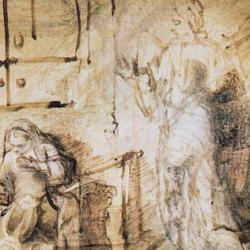Everyone who’s read Genesis 1 knows that Hebrews reckoned time from night till day. “Evening and morning, one day” is a refrain of the creation week (Genesis 1:5, 8, 13, 19, 23, 31). Lamps in the tabernacle burned continually (tamid), that is, from evening till morning (Leviticus 24:3; cf. Exodus 27:21), and the cloud of the Lord’s presence remained above the tabernacle “from evening till morning” (Number 9:21). During Passover, not yeast was to be found in Israelite homes from the sacrifice of the evening of the first day until morning (Deuteronomy 16:4).
That pattern is thrown into reverse midway through the Old Testament. In the kingdom period and after, nearly every passage that uses “evening, morning” in tandem places morning first. Goliath comes to taunt Israelite troops “every morning and evening” (1 Samuel 17:16). Ravens bring bread and meat to Elijah—like worshipers winging their way to offer sacrifice to God—“in the morning . . . and in the evening” (1 Kings 17:6). Ahaz offers ascensions and tributes on his illegitimate altar, ascensions in the morning and grain offerings at night (2 Kings 16:15).
In Chronicles, this reversed pattern is explicitly used to describe the work of priests and Levites. During David’s reign, Zadok and his brothers are left at the Mosaic tabernacle to offer ascensions tamid, “morning and evening” (1 Chronicles 16:39–40). David establishes Levites to offer praise and thanks every morning and evening (1 Chronicles 23:30), and once Solomon builds the temple ascensions are offered “every morning and evening and on Sabbaths, at the New Moons and at the appointed festivals of Yahweh our God” (2 Chronicles 2:4; cf. 2 Chronicles 13:11, 13; Ezra 3:3).
There are anomalous patterns in the Mosaic and Davidic era. moses sits making decisions for Israel “from morning till evening” (Exodus 18:13–14), and the grain offering at the ordination of Aaron is split into a morning and evening offering (Leviticus 6:20). On the other hand, Daniel reckons visionary time as a collection of “evenings and mornings” (Daniel 8:14, 26).
Still, the reversal is too dramatic and the pattern too consistent to be accidental. It implies, at least, that the tabernacle operated by the time of the old creation—from darkness to light—but that the temple operated according to a new temporality—from light to darkness. Once the sun of kingship has risen on Israel, she is in a new day, and her days begin not in darkness but in brilliant light. Already within the old covenant, we have a glimpse of the new era of morning.















